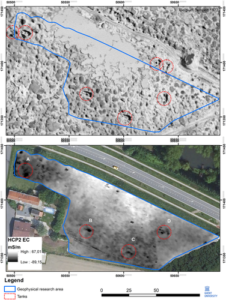
(Archaeological Prospection, 2018)
The archaeology of world war I tanks in the Ypres Salient (Belgium): A non-invasive approach
In the past decade, the research of archaeological remains from World War I has become mainstream. This article uses non-destructive techniques to investigate the possible material remains of tank warfare in Belgium. During World War I, tanks were used for the first time as a ‘land battleship’ in order to break through the stalemate in the trenches. During the Battle of Messines and the Third Battle of Ypres (1917), tanks were used in Belgium to assist a large-scale Allied offensive. The offensive was a complete failure and besides the terrible human cost, many of the tanks became derelict in so-called ‘tank cemeteries’. This article combines historical information, contemporary historical aerial photographs and state-of-the-art geophysical soil sensing to assess the distribution, density and possible material remains of the tank war. Aerial photo-interpretation and geographic information system (GIS)-mapping sheds new light on the location of 97 tank wrecks in the Ypres Salient. Two sites were selected for further geophysical research. By using electromagnetic induction, it was possible to identify the remains of five tanks as geophysical anomalies, which corresponds to a debris field spread. In this article, both non-invasive and non-destructive techniques will demonstrate the significant potential for investigating cases on a landscape scale without any intense interference of the highly disturbed topsoil.
Reference:
Stichelbaut, B., Note, N., Van den Berghe, H., Van Eetvelde, V., Van Meirvenne, M., Bourgeois, J., & Gheyle, W. (2018). The archaeology of First World War tanks in the Ypres Salient (Belgium): a non-invasive approach. Archaeological Prospection.